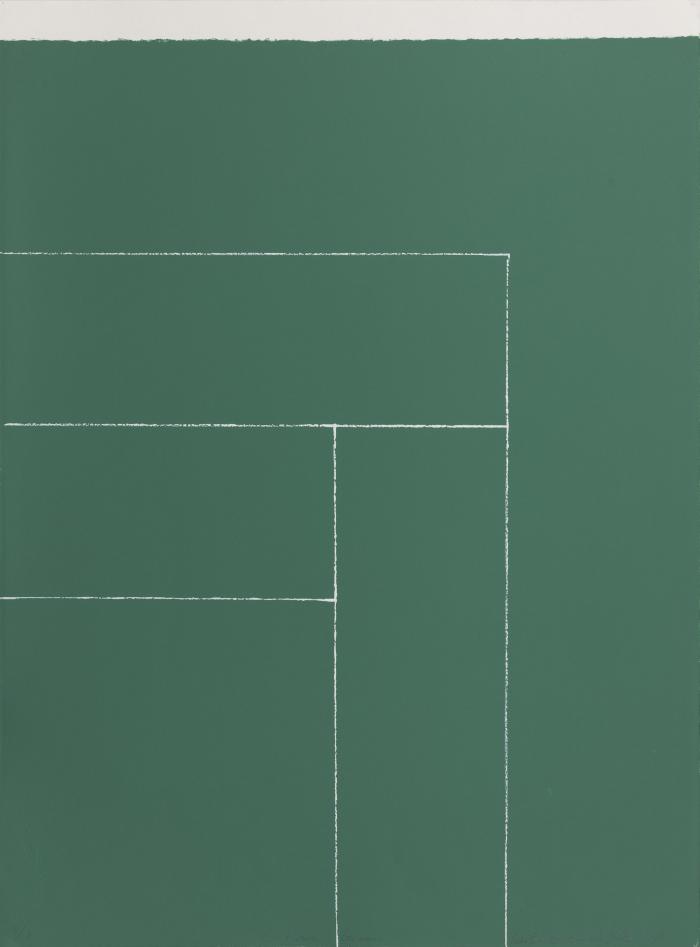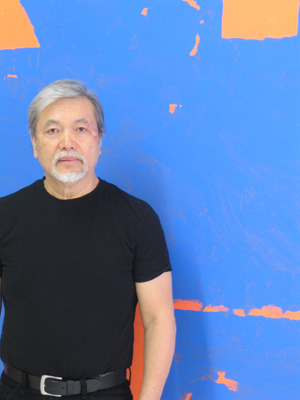
B Bowa Green
Hitoshi Nakazato
- 1981
- Silk Screen
- Image/sheet: 30 x 22"
- 7 prints in this edition
About the Print
From the Artist
My painterly intention is not the discovery or introduction of new things as can be seen in the historical context of art, whether derived from the outside world or inside one’s mind. Then, how do I accomplish the task I have undertaken and image making? The painterly issue is the fusion of, or the attempt to deal with, what may be considered the conflict between the attitude of denial toward the norm and picture making and the desire to paint.
—From Brandywine Workshop and Archives records
[Hitoshi Nakazato’s] prints probe the power of elemental forms, offered in almost infinite combinations, often rendered with startling colors and textures. They speak about absence and presence, stability and motion, and relationships on and off paper.
—Gary Hack, University of Pennsylvania, from https://almanac.upenn.edu/archive/volumes/v53/n33/arg.html, accessed on 7-6-2021

Hitoshi Nakazato
Japanese
Born March 15, 1938 in Machida, Tokyo, Japan
Died July 17, 2010
About the Artist
Japanese painter, printmaker, and mural artist Hitoshi Nakazato was born in Machida, a city within metropolitan Tokyo, Japan. He earned a BFA from Tama Art University, Tokyo; an MS in art from the University of Wisconsin, Madison; and an MFA from the University of Pennsylvania’s Graduate School of Fine Arts, Philadelphia.
Nakazato’s work has been exhibited at Machida City Museum of Graphic Arts, Keikando Gallery at J. F. Oberlin (Obirin) University, and Muramatsu Gallery, all in Tokyo; Arthur Ross Gallery at the University of Pennsylvania, Nesbit Gallery at Drexel University, Pennsylvania Academy of the Fine Arts, and Brandywine Workshop and Archives, all in Philadelphia; and Gallery Juliet, Trieste, Italy, among others.
His work is in the collections of the Museum of Modern Art, New York City; Philadelphia Museum of Art and Pennsylvania Academy of the Fine Arts, Philadelphia; Museum of Modern Art, Kyoto; National Gallery of Art, Washington, DC; Tokyo Metropolitan Art and Machida City Museum of Graphic Arts, Tokyo; Birmingham Museum of Art, AL; and Tikotin Museum of Japanese Art, Haifa, Israel, and other institutions.
Nakazato received the John D. Rockefeller III Fund grant to work in Manhattan, Creative Artists Public Service grant from the State of New York, and Japan/United States Consortium for Environmental Planning and Design grant from Ohio State University, Columbus.
Nakazato lived in Manhattan and was a professor of art at the University of Pennsylvania until his death in 2010.
—From Brandywine Workshop and Archives records
Curriculum Connections
Suggested Topics for Algebra I and Geometry
Algebra I:
The resources provided can be used early on in an Algebra class to help students think in multiple dimen- sions. The artworks can be used to demonstrate illusions intended as a design element or to help students imagine space constructed or deconstructed from forms or shapes within a space. The ability to visualize concepts through art can make advanced math more accessible to students early on.
Geometry:
Some may want to use images in the Artura.org library to explore more complex uses of advanced math to create the illusions of space and solve spatial dynamic issues for three-dimensional works such as stand-alone sculpture and site-specific, public artworks. The laying of bricks or ceramic tiles is a skilled craft that can involve creativity and innovation in bricks or tiles are set and many available options in color, design, and texture are used. Sculptors such as Melvin Edwards, Richard Hunt, and John T. Scott have consistently used higher math concepts in the creation of large scale, space-defining public art.
Questions to Consider
- What are the different considerations between symmetry and asymmetry in relation to designing a structure or composing a work of art?
- What roles can rhythm, repetition, pattern, proportion, and scale play in an architect’s design and construction process? What roles can they plan in making a work of art?
- Other than the design of buildings, where else does one observe the use of the right angle in a creative way and for what purposes?